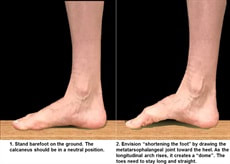 Committing to getting healthy, working out more, finally seeing results is a...journey And one that can come to a grinding halt in on morning with tight, stabbing pain in the heel. While it's easy to walk it off at first, hit the box, and continue on with the day, it becomes more difficult to ignore as the nagging pain in the heel grows stronger. And lingers. And walking becomes nearly unbearable, never mind box jumps and deadlifts. Did this description sound familiar? These are all common signs and symptoms of plantar fasciitis. WHAT IS IT? "Plantar Fasciitis (PF) is an overuse injury that occurs due to excessive loading of the plantar fascia, possibly related to pronation and low arch height, which flattens the medial arch and increases stress on the fascia" TRANSLATED: The plantar fascia is a thick band of connective tissue at the bottom of the foot responsible for absorbing load and creating tension to enable walking, running, and jumping. When the origin of the plantar fascia becomes irritated, it becomes painful. WHAT DOES IT FEEL LIKE? "PF is characterized by pain concentrated at the medial calcaneal tubercle that increases with weight-bearing following periods of non-weightbearing." TRANSLATED: Usually plantar fasciitis is experienced as a sharp pain at the direct center of the heel, off to the inside of it, or all around it. Typically, it hurts most at the beginning walking after sitting/resting for an extended period of time. The pain can also improve as with continued walking, mobility, general movement, etc. WHAT CAUSES IT?
SIGNS AN ATHLETE SHOULD NOT CONTINUE TO EXERCISE AND RUN THROUGH PLANTAR FASCIITIS: While it is possible to continue with an exercise regime despite pain, strong indicators that it’s time to see a physical therapist include:
Consequences could include: "Continuing to run (and exercise) through pain with plantar fasciitis could result in altered gait. Compared to healthy runners, individuals with PF have been shown to have [altered foot mechanics such as]…greater rearfoot eversion, forefoot sagittal range of motion, and first metatarsal phalangeal joint range of motion. Further, individuals with PF have lesser vertical ground reaction forces during propulsion, reduced rearfoot center of pressure (COP), reduced impulse, and reduced peak vertical ground reaction force at loading response as compared to healthy individuals " Translation: When an athlete is struggling through a rough case of plantar fasciitis, foot mechanics will be changed and altered. This can lead to general compensations resulting in further injury, especially during high impact activities such as box jumps, running, etc. HOW TO FIX PLANTAR FASCIITIS A well rounded approach including both manual treatment by a physical therapist and exercise is the best rehab routine! Manual, or hands on, intervention, may include mobilizations of the heel bone to restore calcaneal mobility and soft tissues. This can including blading, dry needling, and more to improve tolerance to symptoms. Exercises your physical therapist may use during your treatment session include:
If you’re wondering whether it’s time to seek out professional care, it’s time. References:
Cheung, R. et al. (2015) “Intrinsic foot muscle volume in runners with and without chronic bilateral plantar fasciitis,” Physiotherapy, 101. Available at: https://doi.org/10.1016/j.physio.2015.03.414. Kelly, D.K., Wiegand, K. and Freedman Silvernail, J. (2022) “Dynamic Stability in runners with and without plantar fasciitis,” Gait & Posture, 96, pp. 301–305. Available at: https://doi.org/10.1016/j.gaitpost.2022.06.003. Osborne, J.W.A. et al. (2019) “Muscle function and muscle size differences in people with and without plantar heel pain: A systematic review,” Journal of Orthopaedic & Sports Physical Therapy, 49(12), pp. 925–933. Available at: https://doi.org/10.2519/jospt.2019.8588. Wiegand, K., Tandy, R. and Freedman Silvernail, J. (2022) “Plantar fasciitis injury status influences foot mechanics during running,” Clinical Biomechanics, 97, p. 105712. Available at: https://doi.org/10.1016/j.clinbiomech.2022.105712. |
Click above for details on any promotions being offered or special events to catch the team at.
Archives
July 2024
Categories |
Huntsville Location |
Athens
|
HoursMon-Thurs: 8am - 5pm
Friday: 8am-5pm |
Contact numbers |
|


